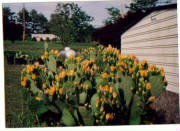 |
|
Cactus and Succulent Plants
|
|
Cactus pics
|
 |
 |
|
Propagation couldn't be easier! Using beaker tongs or a piece of folded newspaper, just cut off a pad. (You can swap pads
with a friend)! Let the wound dry for about a week, then plant the pad in a shallow depression cut side down. Water every
2 weeks to get the roots started. Minimal water is needed. Once every 2 to 3 weeks in the summer is sufficient for new plants.
When established they can generally survive on rainfall alone. As with any herbaceous plant, however, shriveling or wilting
means they need to be watered.
|
 |
|
The flat-jointed paddles of the prickly pear are not leaves, but an adaptation of a stem from which the fruit grows. The cactus
paddles, "Nopales," are also a commonly used ingredient in Mexican recipes, including salads and scrambled eggs.
The prickly pear fruit normally ripens and is ready for harvest during the late summer and early fall months.
|
 |
|
When gathering the fruit, wear leather or rubber gloves to avoid contact with the cactus needles. They are a nuisance, especially
the tiny soft-appearing barbs of glochids on the fruit itself. The glochids are very difficult to remove if you get them in
your skin. A long-handled tong can also be used to pick the fruit from the cactus. Once you have harvested the fruit, you
will need to remove the glochids by passing the fruit through an open flame or shaking the fruit in a bag of hot coals. The
glochids can also be removed by cutting them away with a knife or peeling off the skin. Once the fruit is removed from the
cactus, it will rapidly lose nutritional value and may ferment, so try to consume or process soon after harvesting.
|
 |
|
Like other cactus, most prickly pears and chollas have large spines, modified leaves growing from small, wart-like projections
on their stems. Opuntia genus are unique; clusters of fine, tiny, barbed spines called glochids, Found just above the cluster
of regular spines, yellow or red in color and detach easily from the pads, are often difficult to see and more difficult to
remove.
|
 |

The plants are the large outdoor variety, and are excellent for landscaping. They bloom in the spring with large yellow flowers.
When the blooms die they form large purple pods that are quite attractive as well!
These cacti can survive freezing and grow 12 inches and more each year, forming new leaves and growing to 4 and 5 feet
in height.
|
 |
|
|
|
